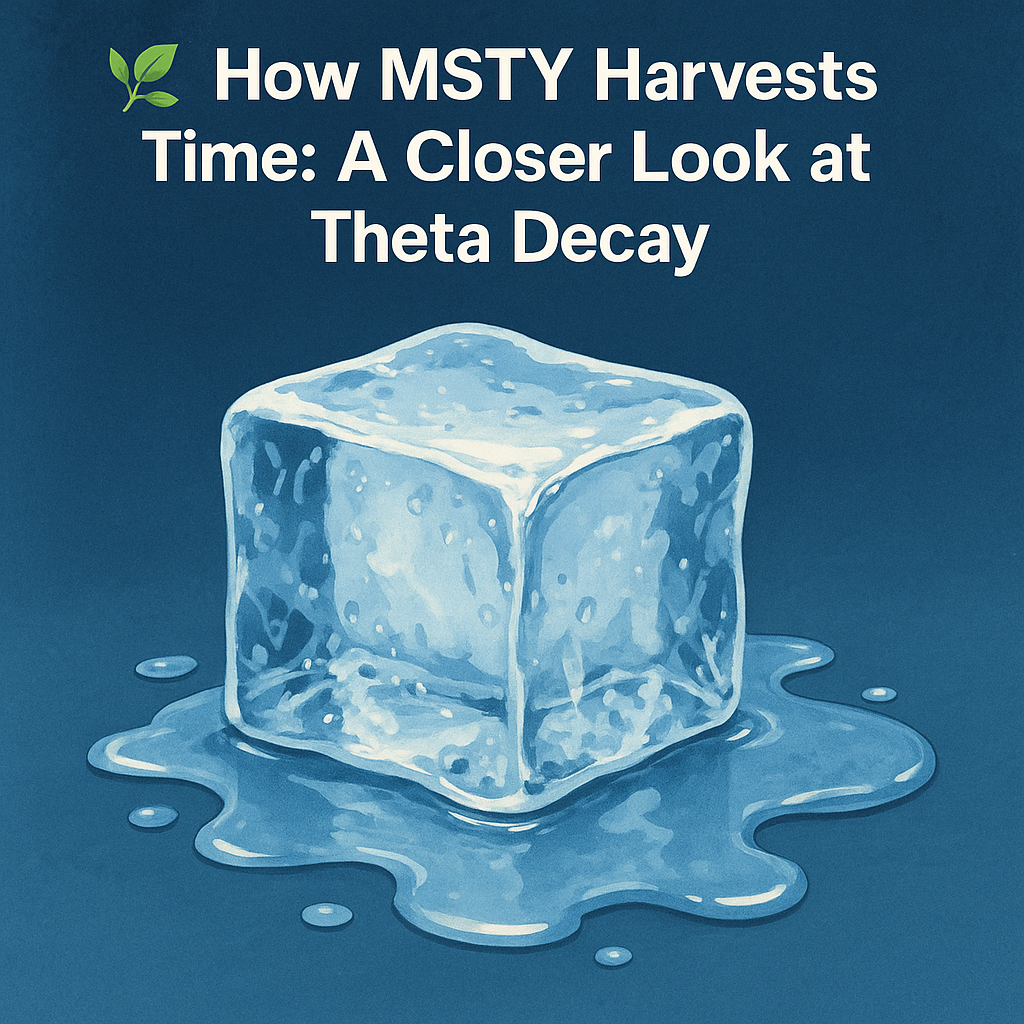1. Recap: What is Theta Decay, Anyway?
Before we can see how MSTY turns theta decay into cash, let’s briefly define what theta is in the options world.
Options are contracts that give buyers certain rights:
- Call Option: the right to buy an asset at a set price.
- Put Option: the right to sell an asset at a set price.
Each option has a value that comes in two parts:
Intrinsic Value:
- How much is this option worth right now if you exercised it?
- For example, if Strategy’s stock is $400, and you have a call option with a strike price of $350, you could buy for $350 and instantly sell for $400, pocketing $50.
- This $50 is intrinsic value.
Extrinsic Value (Time Value):
- This is the value of possibility.
- Even if your option isn’t worth anything today, it could become valuable before it expires.
- The more time you have, the more chance for surprises.
Theta decay measures how much that time value melts away each day as the option approaches expiry.
2. Visual Metaphor: The Ice Cube
Imagine an ice cube on a sunny table:
- Day 1: Full of potential — could last a while.
- Day 10: Smaller, shrinking steadily.
- Day 20: Almost gone.
Theta is the drip of water every minute.
The closer you get to the end (expiration), the faster the melting.
This is why options that expire in a few days lose value faster than those expiring in months.
3. MSTY’s Strategy: The Theta Harvest
MSTY is engineered to capture this melting time value over and over.
Let’s look step by step.
Step 1: The Synthetic Long
First, MSTY constructs a synthetic long position in Strategy stock.
Recall this formula:
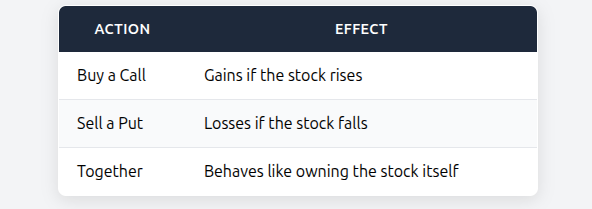
This synthetic position behaves as if MSTY owns the shares, but without buying them outright.
This step alone doesn’t generate income — it just sets the stage.
Step 2: Selling Covered Calls
Next, MSTY sells call options on top of the synthetic long.
These are near-dated (usually expiring in 4–5 weeks) and near-the-money (close to the stock’s current price).
When MSTY sells a call, what happens?
- It receives a premium in cash upfront.
- This premium is mostly extrinsic value (time value).
- The buyer of the option is paying MSTY for the chance that Strategy’s price will rise above the strike before expiry.
Imagine MSTY sells one call for $30 per share.
If nothing changes, and the option expires worthless, MSTY keeps the entire $30.
But why would it likely expire worthless?
This is where theta comes in.
Step 3: Waiting While Theta Works
From the moment MSTY sells that call, time starts working in MSTY’s favor.
Every day that passes:
- The extrinsic value shrinks, because there is less time for the stock to move dramatically.
- Even if the stock doesn’t budge, the option gets cheaper.
This daily erosion is theta decay.
Step 4: Buying Back the Option (or Letting It Expire)
MSTY does not always wait until expiration to close the position.
Usually, after 3–4 weeks (out of the 4–5 week window), the option has lost most of its time value.
MSTY can then buy it back at a cheaper price, locking in a profit.
Example:
- Day 1: Sells call for $30.
- Day 20: Buys back for $5.
- Profit: $25 per share.
This process repeats every month.
4. A Table of Theta Over Time
To help visualize how this decay accelerates, here’s a simplified table:
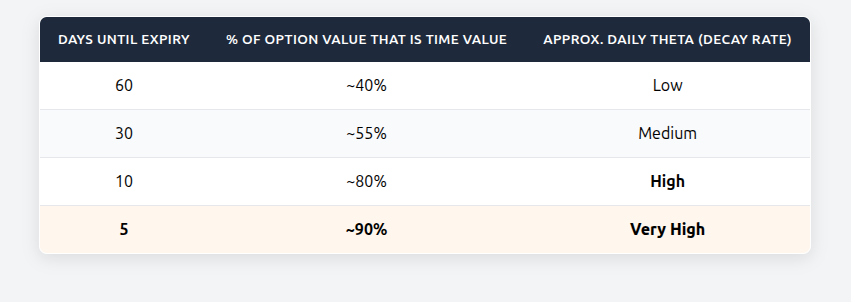
Notice how the final days before expiry are when time value melts the fastest.
5. Why Volatility Makes Theta Bigger
This is where Strategy’s unique risk profile supercharges MSTY’s income.
Recall:
Volatility increases the size of the ice cube.
The formula is:
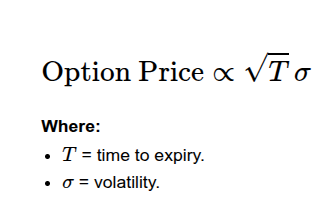
High volatility means:
- Bigger premiums when selling options.
- More extrinsic value to decay.
- More income potential when options shrink in price.
Since Strategy’s stock is leveraged to Bitcoin (which is volatile), MSTY often sells options at generous premiums.
6. The Monthly Cycle: From Sale to Income
Let’s walk through a typical month:

Each cycle ends with MSTY holding:
- Realized cash income from decayed options.
- A fresh synthetic long ready for the next month.
7. Mathematical Example: A Month in Numbers
Let’s make this more concrete.
Assumptions:
- Strategy’s stock = $400.
- Sold call premium = $30.
- Daily theta decay = ~$1.20 per day (accelerating over time).
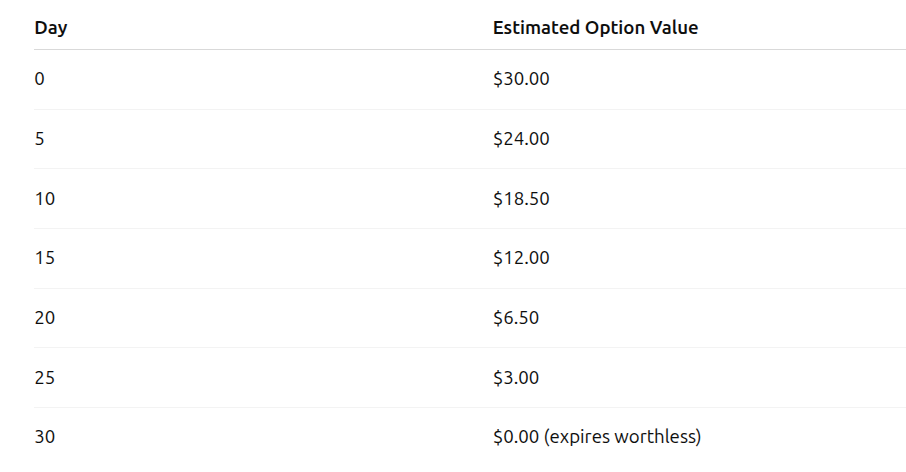
If MSTY buys back on Day 20 for $6.50:
- Gross profit: $23.50 per share.
Multiply this by the number of contracts and you get the monthly income base.
8. What About the Risk?
This process is not without peril:
- If Strategy’s stock skyrockets, the calls become deep in the money.
- The decay still happens, but the intrinsic value rises faster.
- MSTY may have to buy back the calls at a loss to avoid bigger assignments.
- If the stock crashes, the synthetic long loses value.
- The call premium helps offset losses, but cannot eliminate them.
This is why MSTY works best in calm or mildly volatile environments, not when Bitcoin is mooning or crashing.
9. Why This Strategy Appeals to Some Investors
Many people find this approach attractive because:
- It generates predictable income.
- It can be smoother than just holding Bitcoin or Strategy’s stock.
- It offers a sense of control — like harvesting a crop every month.
But remember:
Most of the income is not new wealth.
It’s time value that melts away — a delicate, predictable phenomenon, but one that sits atop an underlying risky asset.
10. Closing Thoughts: The Philosophy of Time Decay
MSTY is, at its heart, a machine that monetizes the passage of time.
Every evening, a little uncertainty disappears from the options it has sold, and that evaporation turns into cash.
Metaphor:
If direct Bitcoin ownership is like standing in the open sea — free but exposed — MSTY is like sitting on a ship with a sail that catches every breeze of time decay.
Sometimes you glide forward. Sometimes the ocean is too wild for comfort. But the mechanism remains the same: the clock keeps ticking, and the premium keeps shrinking.
Summary: How MSTY Makes Money with Theta Decay
- Constructs a synthetic long to replicate Strategy’s stock movements.
- Sells near-dated, near-the-money call options, collecting premium.
- Waits as time passes, causing the options to lose extrinsic value.
- Buys back the options cheaper (or lets them expire).
- Distributes the net income, often labeled “yield,” but largely return of capital.
- Repeats the process every month.
It is, in a way, an elegant dance with time — one that offers steady payouts if you understand the mechanics and accept the risks.
🌿 How MSTY Harvests Time: A Closer Look at Theta Decay was originally published in The Capital on Medium, where people are continuing the conversation by highlighting and responding to this story.
